User Manual
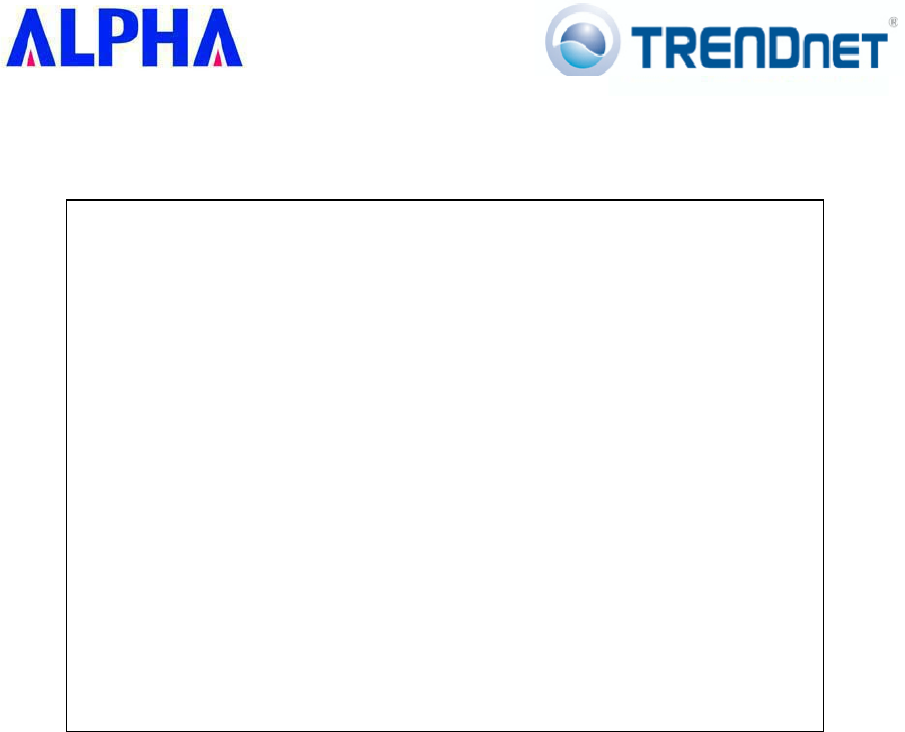
Alpha Networks Proprietary and Confidential Information
1
User manual
For
802.11b/g/n USB Adapter
(Ralink RT3070)
Model Number: WUS-N10M
Revision: 1.0
WLAN Card

Alpha Networks Proprietary and Confidential Information
2
Revision History
Rev. Date Author Reason for Changes
1.0 Jun. 22,2010 Dephany Liu • New released

Alpha Networks Proprietary and Confidential Information
3
Contents
2SHUDWLRQ0DQXDO
1.0 SCOPE...............................................................................................................................................................................
1.1 DOCUMENT......................................................................................................................................................................
1.2 PRODUCT FEATURES........................................................................................................................................................
2.0 REQUIREMENTS ...........................................................................................................................................................
2.1 FUNCTIONAL BLOCK DIAGRAM .......................................................................................................................................
2.2 GENERAL REQUIREMENTS ...............................................................................................................................................
2.2.1 IEEE 802.11b Section..............................................................................................................................................
2.2.2 IEEE 802.11g Section..............................................................................................................................................
2.2.3 IEEE 802.11n Section..............................................................................................................................................
2.2.4 General Section .......................................................................................................................................................
2.3 SOFTWARE REQUIREMENTS .............................................................................................................................................
2.3.1 Information..............................................................................................................................................................
2.3.2 Configuration ..........................................................................................................................................................
2.3.3 Encryption ...............................................................................................................................................................
2.4 MECHANICAL REQUIREMENTS.........................................................................................................................................
2.5 COMPATIBILITY REQUIREMENTS......................................................................................................................................
2.6 REQUIREMENTS OF RELIABILITY, MAINTAINABILITY AND QUALITY ................................................................................
2.7 ENVIRONMENTAL REQUIREMENTS...................................................................................................................................
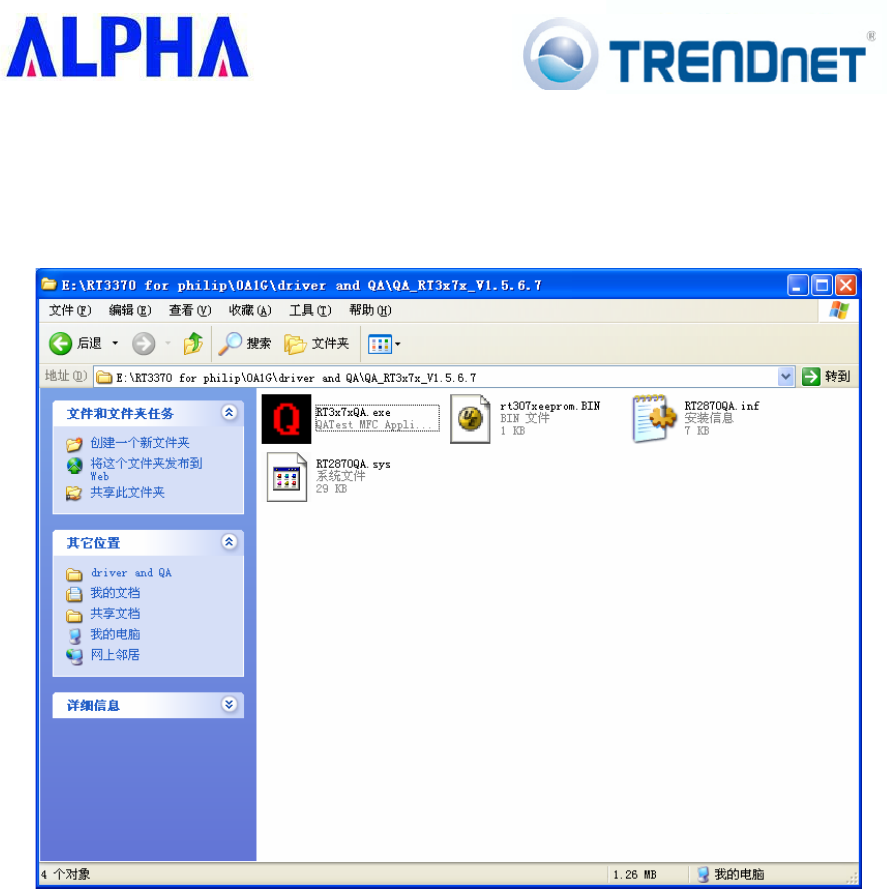
2SHUDWLRQ0DQXDO
$OSKD1HWZRUNV3URSULHWDU\DQG&RQILGHQWLDO,QIRUPDWLRQ
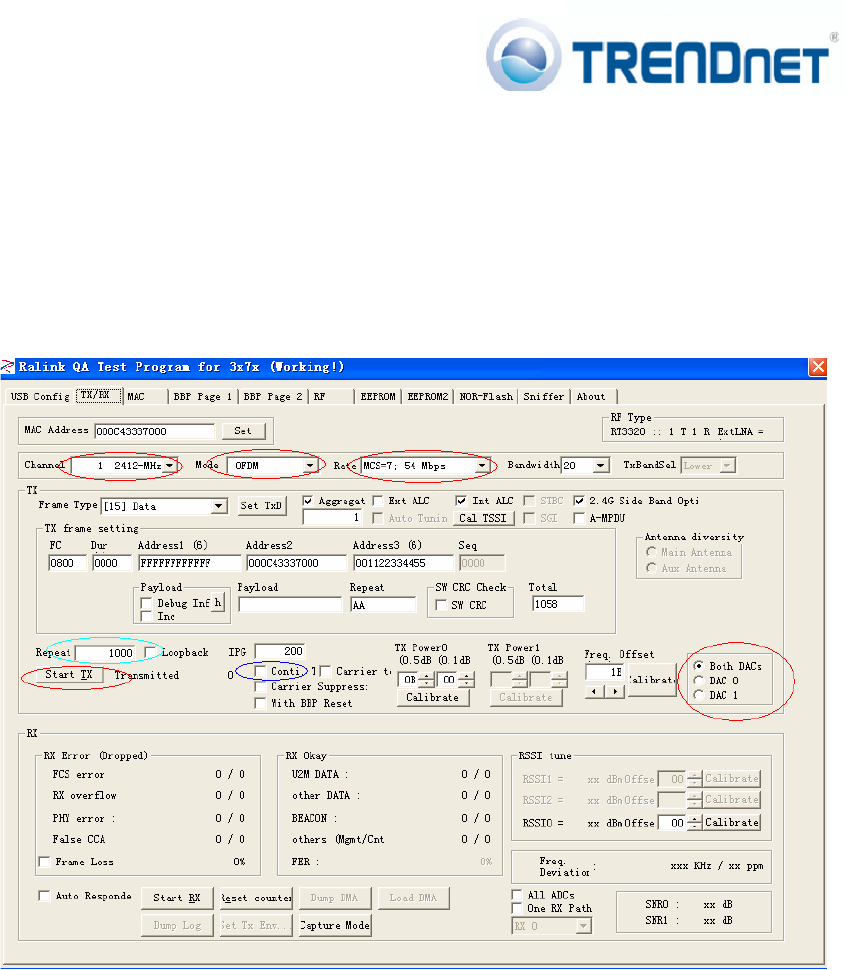
7;VLJQDOFRPPDQG
6HOHFW7;5;VLWH
6HOHFWFKDQQHOGDWDUDWHDQG&KDLQ
)RUFRQWLQXH7;VHOHFWFRQWLSUHVVVWDUWW[
)RUFRQWLQXHSDFNHWVW[VHWUHSHDWWRSUHVVVWDUWW[
$OSKD1HWZRUNV3URSULHWDU\DQG&RQILGHQWLDO,QIRUPDWLRQ
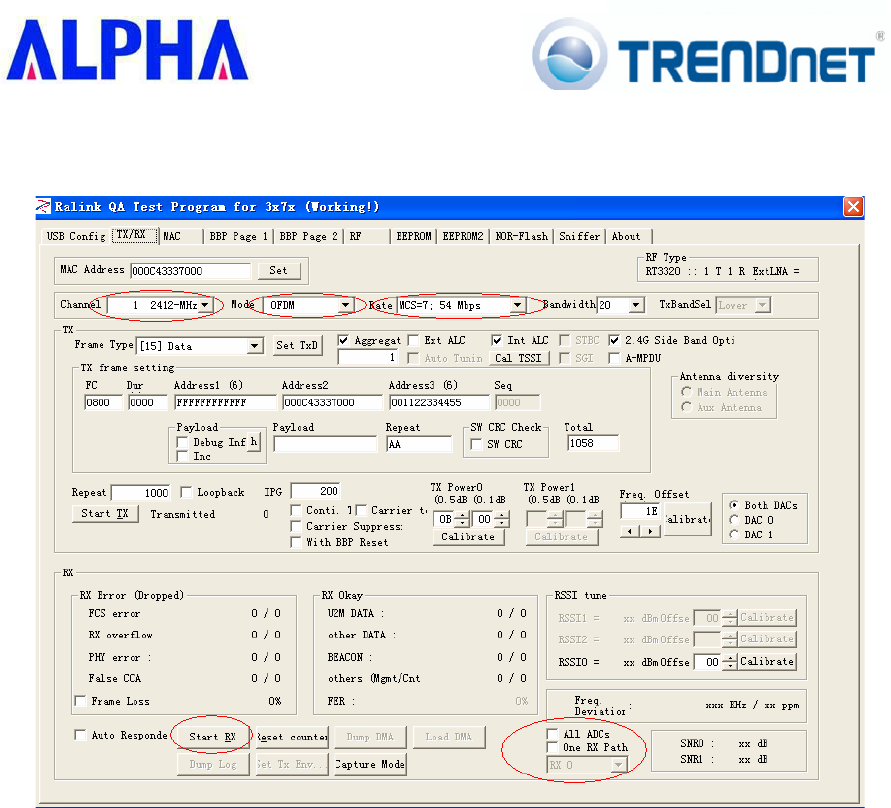
5;VLJQDOFRPPDQG
6HOHFW7;5;VLWH
6HOHFWFKDQQHOGDWDUDWHDQG&KDLQ
$OSKD1HWZRUNV3URSULHWDU\DQG&RQILGHQWLDO,QIRUPDWLRQ

Alpha Networks Proprietary and Confidential Information
1.0 Scope
1.1 Document
This document is to specify the product requirements for 802.11 b/g/n USB Dongle. This Card is based on Ralink chipset
that complied with IEEE 802.11g, IEEE 802.11b, IEEE 802.11n standard from 2.4~2.5GHz, and it can be used to provide
up to 54Mbps for 802.11g, 11Mbps for 802.11b and 150Mbps for 802.11n to connect your wireless LAN.
With seamless roaming, fully interoperability and advanced security with WEP standard, 802.11b/g/n USB Dongle offers
absolute interoperability with different vendors’ 802.11g, 802.11b and 802.11n Access Points through the wireless LAN.
1.2 Product Features
y Compatible with IEEE 802.11n draft 2.0 standard to provide wireless 150Mbps data rate.
y Compatible with IEEE 802.11g standard to provide wireless 54Mbps data rate
y Compatible with IEEE 802.11b standard to provide wireless 11Mbps data rate
y Operation at 2.4 ~ 2.5GHz frequency band to meet worldwide regulations
y Dynamic date rate scaling at 6, 9, 12, 18, 24, 36, 48, 54 for IEEE 802.11g.
y Dynamic date rate scaling at 1, 2, 5.5, and 11Mbps for IEEE 802.11b
y Maximum reliability, throughput and connectivity with automatic data rate switching
y Support wireless data encryption with 64/128-bit WEP for security
y Support infrastructure networks via Access Point and ad-hoc network via peer-to-peer communication
y Support WEP, 802.1x, WPA and WPA2 enhanced security
y Friendly user configuration and utilities
y Drivers support Windows 2K, XP 32/64-bit, Vista 32/ 64-bit
y Support external WPS button to connect Access Point easily
y High speed USB 2.0 interface
y RoHS compliant
WLAN Card
T
his document is to specify the product requirements for WLAN Card. This Card is based on Ralink chipset
that complied with IEEE 802.11g, IEEE 802.11b, IEEE 802.11n standard from 2.4~2.5GHz, and it can be used to provide
up to 54Mbps for 802.11g, 11Mbps for 802.11b and 150Mbps for 802.11n to connect your wireless LAN.
With seamless roaming, fully interoperability and advanced security with WEP standard, WLAN Card offers
absolute interoperability with different vendors’ 802.11g, 802.11b and 802.11n Access Points through the wireless LAN.

Federal Communication Commission Interference Statement
This device complies with Part 15 of the FCC Rules. Operation is subject to the following two
conditions: (1) This device may not cause harmful interference, and (2) this device must
accept any interference received, including interference that may cause undesired operation.
This equipment has been tested and found to comply with the limits for a Class B digital
device, pursuant to Part 15 of the FCC Rules. These limits are designed to provide
reasonable protection against harmful interference in a residential installation. This equipment
generates, uses and can radiate radio frequency energy and, if not installed and used in
accordance with the instructions, may cause harmful interference to radio communications.
However, there is no guarantee that interference will not occur in a particular installation. If
this equipment does cause harmful interference to radio or television reception, which can be
determined by turning the equipment off and on, the user is encouraged to try to correct the
interference by one of the following measures:
- Reorient or relocate the receiving antenna.
- Increase the separation between the equipment and receiver.
- Connect the equipment into an outlet on a circuit different from that
to which the receiver is connected.
- Consult the dealer or an experienced radio/TV technician for help.
FCC Caution: Any changes or modifications not expressly approved by the party responsible
for compliance could void the user's authority to operate this equipment.
This transmitter must not be co-located or operating in conjunction with any other antenna or
transmitter.
Radiation Exposure Statement:
This equipment complies with FCC radiation exposure limits set forth for an uncontrolled
environment. This equipment should be installed and operated with minimum distance 20cm
between the radiator & your body.

This device is intended only for OEM integrators under the following conditions:
1) The antenna must be installed such that 20 cm is maintained between the antenna and
users, and
2) The transmitter module may not be co-located with any other transmitter or antenna.
As long as 2 conditions above are met, further transmitter test will not be required. However,
the OEM integrator is still responsible for testing their end-product for any additional
compliance requirements required with this module installed
IMPORTANT NOTE: In the event that these conditions can not be met (for example certain
laptop configurations or co-location with another transmitter), then the FCC authorization is
no longer considered valid and the FCC ID can not be used on the final product. In these
circumstances, the OEM integrator will be responsible for re-evaluating the end product
(including the transmitter) and obtaining a separate FCC authorization.
End Product Labeling
This transmitter module is authorized only for use in device where the antenna may be installed
such that 20 cm may be maintained between the antenna and users. The final end product must be
labeled in a visible area with the following: “Contains FCC ID: RRKWUSN10M”. The grantee's
FCC ID can be used only when all FCC compliance requirements are met.
Manual Information To the End User
The OEM integrator has to be aware not to provide information to the end user regarding how to
install or remove this RF module in the user’s manual of the end product which integrates this
module.
The end user manual shall include all required regulatory information/warning as show in this
manual.
labeled in a visible area with the following: “Contains FCC ID: XU8WUSN10M”. The grantee's

Industry Canada statement:
This device complies with RSS-210 of the Industry Canada Rules. Operation is subject to the following
two conditions: (1) This device may not cause harmful interference, and (2) this device must accept any
interference received, including interference that may cause undesired operation.
Ce dispositif est conforme à la norme CNR-210 d'Industrie Canada applicable aux appareils radio
exempts de licence. Son fonctionnement est sujet aux deux conditions suivantes: (1) le dispositif ne
doit pas produire de brouillage préjudiciable, et (2) ce dispositif doit accepter tout brouillage reçu, y
compris un brouillage susceptible de provoquer un fonctionnement indésirable.
Radiation Exposure Statement:
This equipment complies with IC radiation exposure limits set forth for an uncontrolled environment.
This equipment should be installed and operated with minimum distance 20cm between the radiator &
your body.
Déclaration d'exposition aux radiations:
Cet équipement est conforme aux limites d'exposition aux rayonnements IC établies pour un
environnement non contrôlé. Cet équipement doit être installé et utilisé avec un minimum de 20 cm de
distance entre la source de rayonnement et votre corps.
This device is intended only for OEM integrators under the following conditions: (For module device
use)
፧
1) The antenna must be installed such that 20 cm is maintained between the antenna and users, and
2) The transmitter module may not be co-located with any other transmitter or antenna.
As long as 2 conditions above are met, further transmitter test will not be required. However, the OEM
integrator is still responsible for testing their end-product for any additional compliance requirements
required with this module installed.
Cet appareil est conçu uniquement pour les intégrateurs OEM dans les conditions suivantes:
(Pour utilisation de dispositif module)
1) L'antenne doit être installée de telle sorte qu'une distance de 20 cm est respectée entre l'antenne et les
utilisateurs, et
2) Le module émetteur peut ne pas être coïmplanté avec un autre émetteur ou antenne.
Tant que les 2 conditions ci-dessus sont remplies, des essais supplémentaires sur l'émetteur ne seront
pas nécessaires. Toutefois, l'intégrateur OEM est toujours responsable des essais sur son produit final
pour toutes exigences de conformité supplémentaires requis pour ce module installé.

IMPORTANT NOTE:
In the event that these conditions can not be met (for example certain laptop configurations or
co-location with another transmitter), then the Canada authorization is no longer considered valid and
the IC ID can not be used on the final product. In these circumstances, the OEM integrator will be
responsible for re-evaluating the end product (including the transmitter) and obtaining a separate
Canada authorization.
NOTE IMPORTANTE:፧
Dans le cas où ces conditions ne peuvent être satisfaites (par exemple pour certaines configurations
d'ordinateur portable ou de certaines co-localisation avec un autre émetteur), l'autorisation du Canada
n'est plus considéré comme valide et l'ID IC ne peut pas être utilisé sur le produit final. Dans ces
circonstances, l'intégrateur OEM sera chargé de réévaluer le produit final (y compris l'émetteur) et
l'obtention d'une autorisation distincte au Canada.
End Product Labeling
This transmitter module is authorized only for use in device where the antenna may be installed such
that 20 cm may be maintained between the antenna and users. The final end product must be labeled in
a visible area with the following: “Contains IC: 4833A-WUSN10M”.
Plaque signalétique du produit final
Ce module émetteur est autorisé uniquement pour une utilisation dans un dispositif où l'antenne peut
être installée de telle sorte qu'une distance de 20cm peut être maintenue entre l'antenne et les
utilisateurs. Le produit final doit être étiqueté dans un endroit visible avec l'inscription suivante:
"Contient des IC: 4833A-WUSN10M ".
Manual Information To the End User
The OEM integrator has to be aware not to provide information to the end user regarding how to install
or remove this RF module in the user’s manual of the end product which integrates this module.
The end user manual shall include all required regulatory information/warning as show in this manual.
Manuel d'information à l'utilisateur final
L'intégrateur OEM doit être conscient de ne pas fournir des informations à l'utilisateur final quant à la
façon d'installer ou de supprimer ce module RF dans le manuel de l'utilisateur du produit final qui
intègre ce module.
Le manuel de l'utilisateur final doit inclure toutes les informations réglementaires requises et
avertissements comme indiquͼ dans ce manuel.
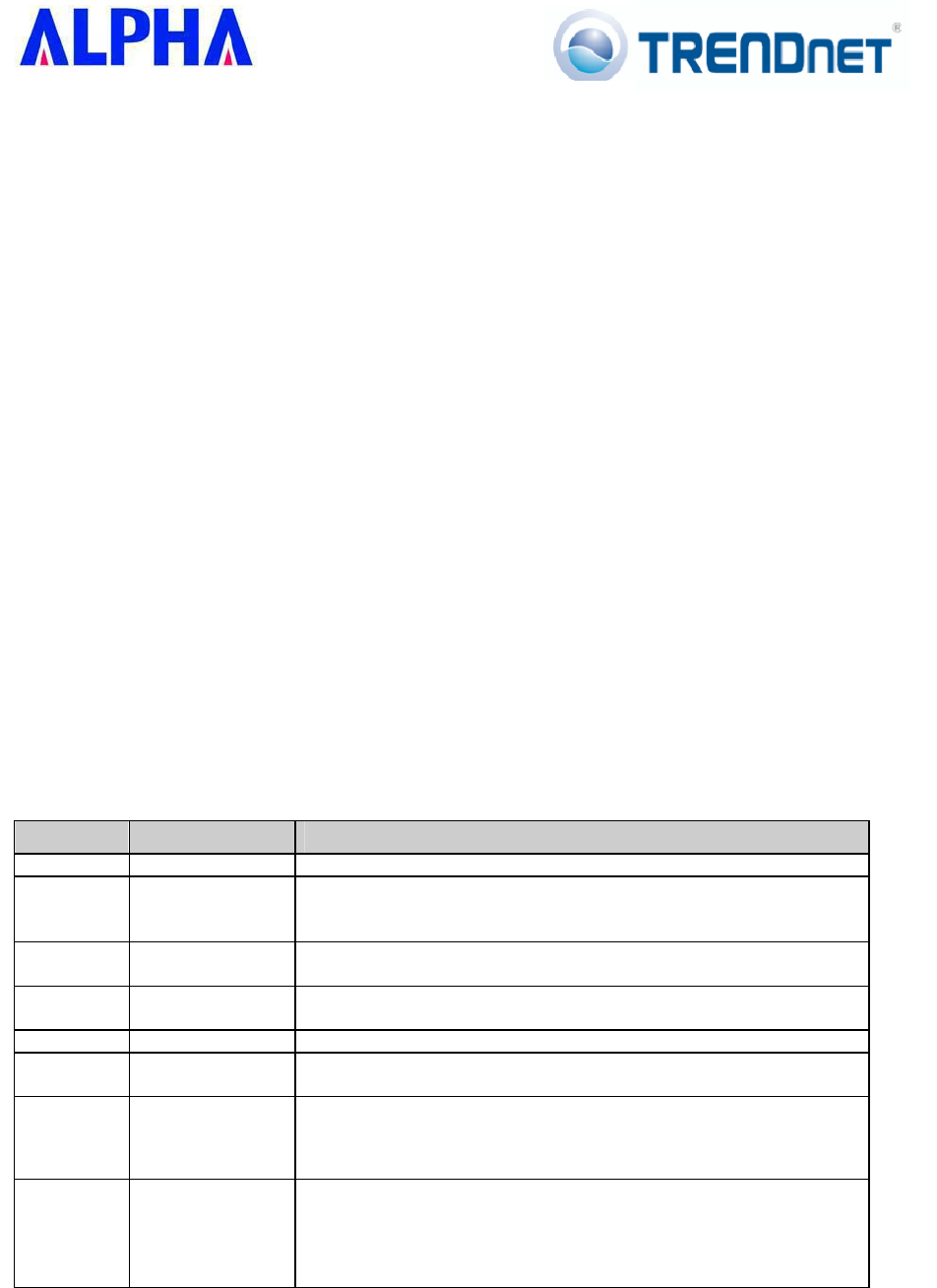
Alpha Networks Proprietary and Confidential Information
2.0 Requirements
The following sections identify the detailed requirements of the 802.11n Draft 2.0 USB Dongle.
2.1 Functional Block Diagram
2.2 General Requirements
2.2.1 IEEE 802.11b Section
# Feature Detailed Description
2.2.1.1 Standard y IEEE 802.11b
2.2.1.2 Radio and
Modulation
Schemes
y DQPSK, DBPSK, DSSS, and CCK
2.2.1.3 Operating
Frequency
y 2400 ~ 2497MHz ISM band
2.2.1.4 Channel Numbers y 11 channels for United States
13 channels for Europe Countries and other regions
2.2.1.5 Data Rate y 11, 5.5, 2, and 1Mbps
2.2.1.6 Media Access
Protocol
y CSMA/CA with ACK
2.2.1.7 Transmitter Output
Power
y Typical RF Output Power (tolerance +-2 dB) at each RF chain, Data
Rate and at room Temp. 25degree C
y 17 dBm at 1,2,5.5,11Mbps
Note: The maximum power setting will vary according to individual country regulations.
2.2.1.8 Receiver Sensitivity
y Typical Sensitivity at each RF chain. Frame (1000-byte PDUs) Error
Rate = 8%
y –94dBm at 1Mbps
y –92dBm at 2Mbps
y –90dBm at 5.5Mbps
2:eCn!
2400 ~ 2483.5MHz ISM band
T
he following sections identify the detailed requirements of the WLAN Card.
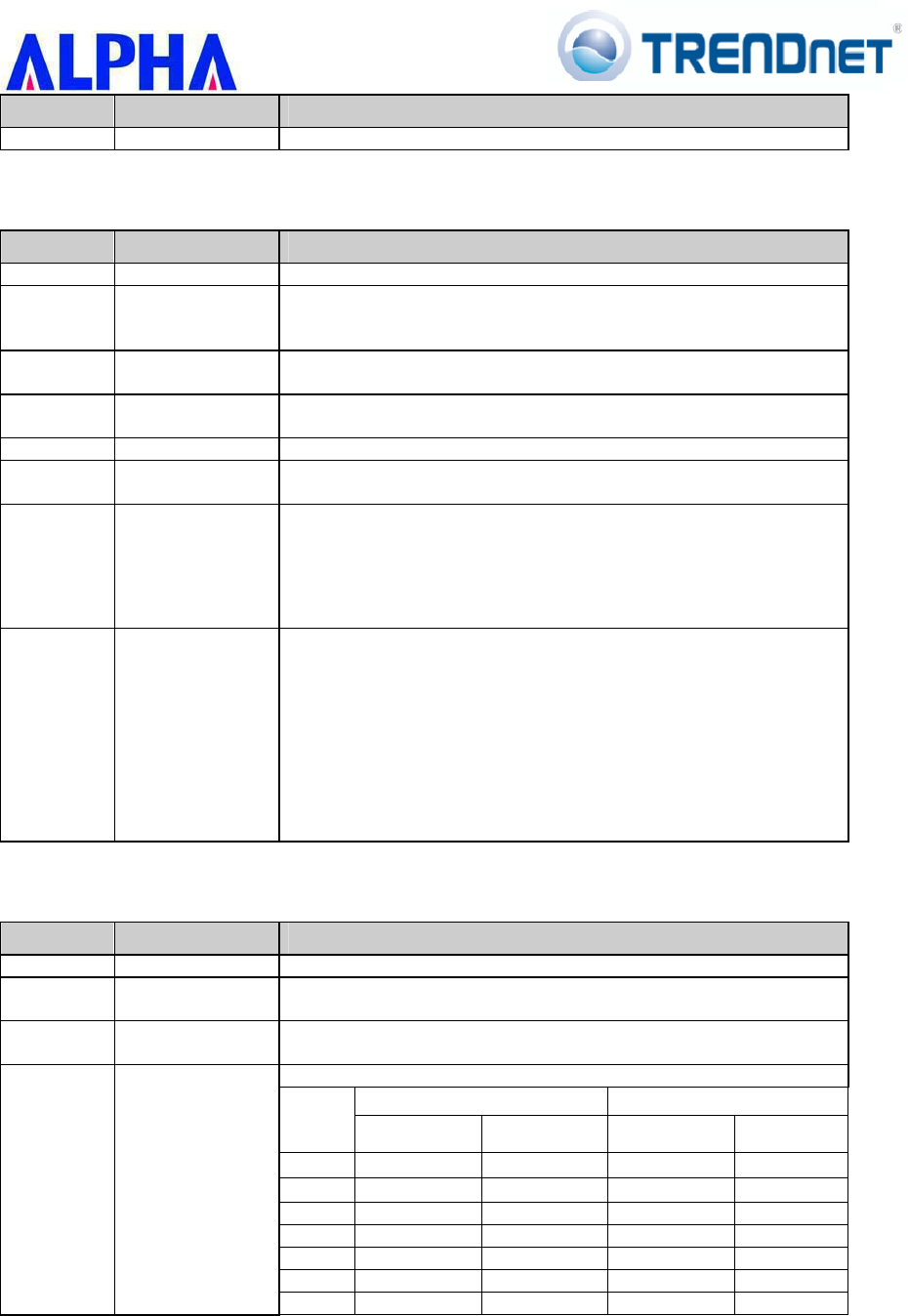
Alpha Networks Proprietary and Confidential Information
# Feature Detailed Description
y –88dBm for 11Mbps
2.2.2 IEEE 802.11g Section
# Feature Detailed Description
2.2.2.1 Standard y IEEE 802.11g
2.2.2.2 Radio and
Modulation
Schemes
y BPSK, QPSK, 16QAM, 64QAM, and OFDM
2.2.2.3 Operating
Frequency
y 2400 ~ 2483.5MHz ISM band
2.2.2.4 Channel Numbers y 11 channels for United States
13 channels for Europe Countries and other regions
2.2.2.5 Data Rate y 6,9,12,18,24,36,48,54Mbps
2.2.2.6 Media Access
Protocol
y CSMA/CA with ACK
2.2.2.7 Transmitter Output
Power
y Typical RF Output Power (tolerance +-2dB) at each RF chain, Data
Rate and at room Temp. 25degree C
y 16dBm at 12 ~ 6 Mbps
y 15dBm at 24,36 Mbps
y 14dBm at 54,48 Mbps
Note: The maximum power setting will vary according to individual country regulations.
2.2.2.8 Receiver Sensitivity
y Typical Sensitivity at each RF chain. Frame (1000-byte PDUs) Error
Rate <10%
y –88dBm at 6Mbps
y –86dBm at 9Mbps
y –84dBm at 12Mbps
y –85dBm at 18Mbps
y –78dBm at 24Mbps
y –76dBm at 36Mbps
y –74dBm at 48Mbps
y –72dBm at 54Mbps
2.2.3 IEEE 802.11n Section
# Feature Detailed Description
2.2.3.1 Standard y Draft 11n
2.2.3.2 Radio and
Modulation Type
y BPSK, QPSK, 16QAM, 64QAM with OFDM
2.2.3.3 Operating
Frequency
y 2400 ~ 2483.5MHz ISM band
GI=800ns GI=400ns
MCS 20MHz 40MHz 20MHz 40MHz
0 6.5 13.5 7.2 15
1 13 27 14.4 30
2 19.5 40.5 21.7 45
3 26 54 28.9 60
4 39 81 43.3 90
5 52 108 57.8 120
2.2.3.4 Data Rate
6 58.5 121.5 65.0 135
33eCn!
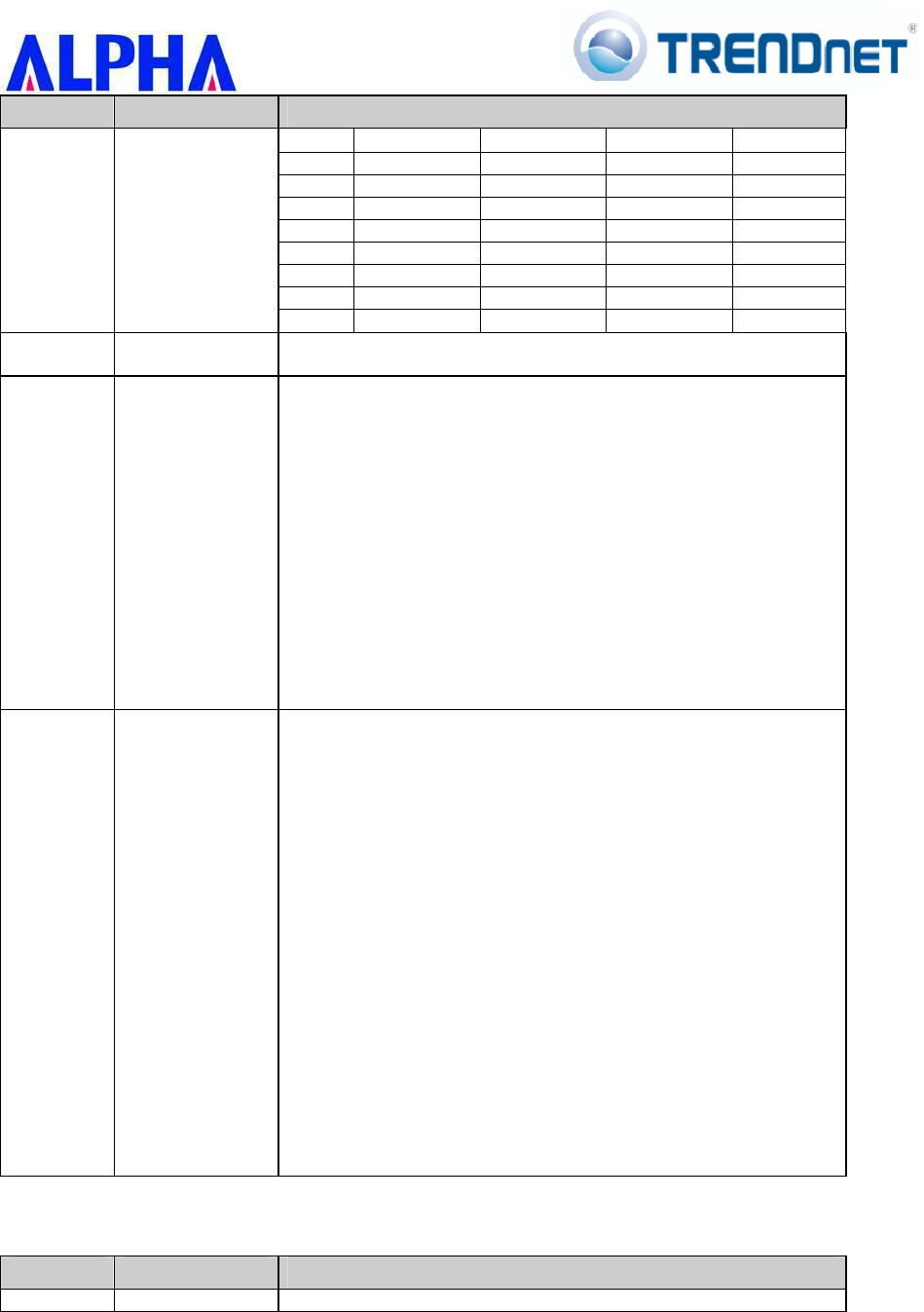
Alpha Networks Proprietary and Confidential Information
# Feature Detailed Description
7 65 135 72.2 150
8 13 27 14.444 30
9 26 54 28.889 60
10 39 81 43.333 90
11 52 108 57.778 120
12 78 162 86.667 180
13 104 216 115.556 240
14 117 243 130.000 170
15 130 270 144.444 300
2.2.3.5
Media Access
Protocol
y CSMA/CA with ACK
2.2.3.6 Transmitter Output
Power at Antenna
Connector
y Typical RF Output Power (tolerance +-2dB) at each RF chain, Data
Rate and at room Temp. 25degree C
y Note: The maximum power setting will vary according to individual country
regulations
2.4GHz Band/HT-20
y 16dBm at MCS0/1
y 16dBm at MCS2/3
y 15dBm at MCS4/5
y 14dBm at MCS6/7
2.4GHz Band/HT-40
y 15dBm at MCS0/1
y 15dBm at MCS2/3
y 14dBm at MCS4/5
y 13dBm at MCS6/7
2.2.3.7 Receiver Sensitivity
at Antenna
Connector
y Typical Sensitivity at Which Frame (1000-byte PDUs) Error Rate =
10% and at room Temp. 25degree C
2.4GHz Band/HT-20
y –86dBm at MCS0/8
y –84dBm at MCS1/9
y –82dBm at MCS2/10
y –80dBm at MCS3/11
y –78dBm at MCS4/12
y –76dBm at MCS5/13
y –74dBm at MCS6/14
y –72dBm at MCS7/15
2.4GHz Band/HT-40
y –87dBm at MCS0/8
y –83dBm at MCS1/9
y –81dBm at MCS2/10
y –78dBm at MCS3/11
y –76dBm at MCS4/12
y –72Bm at MCS5/13
y –70dBm at MCS6/14
y –68dBm at MCS7/15
2.2.4 General Section
# Feature Detailed Description
2.2.4.1 Antenna Type y External antenna
33eCn!
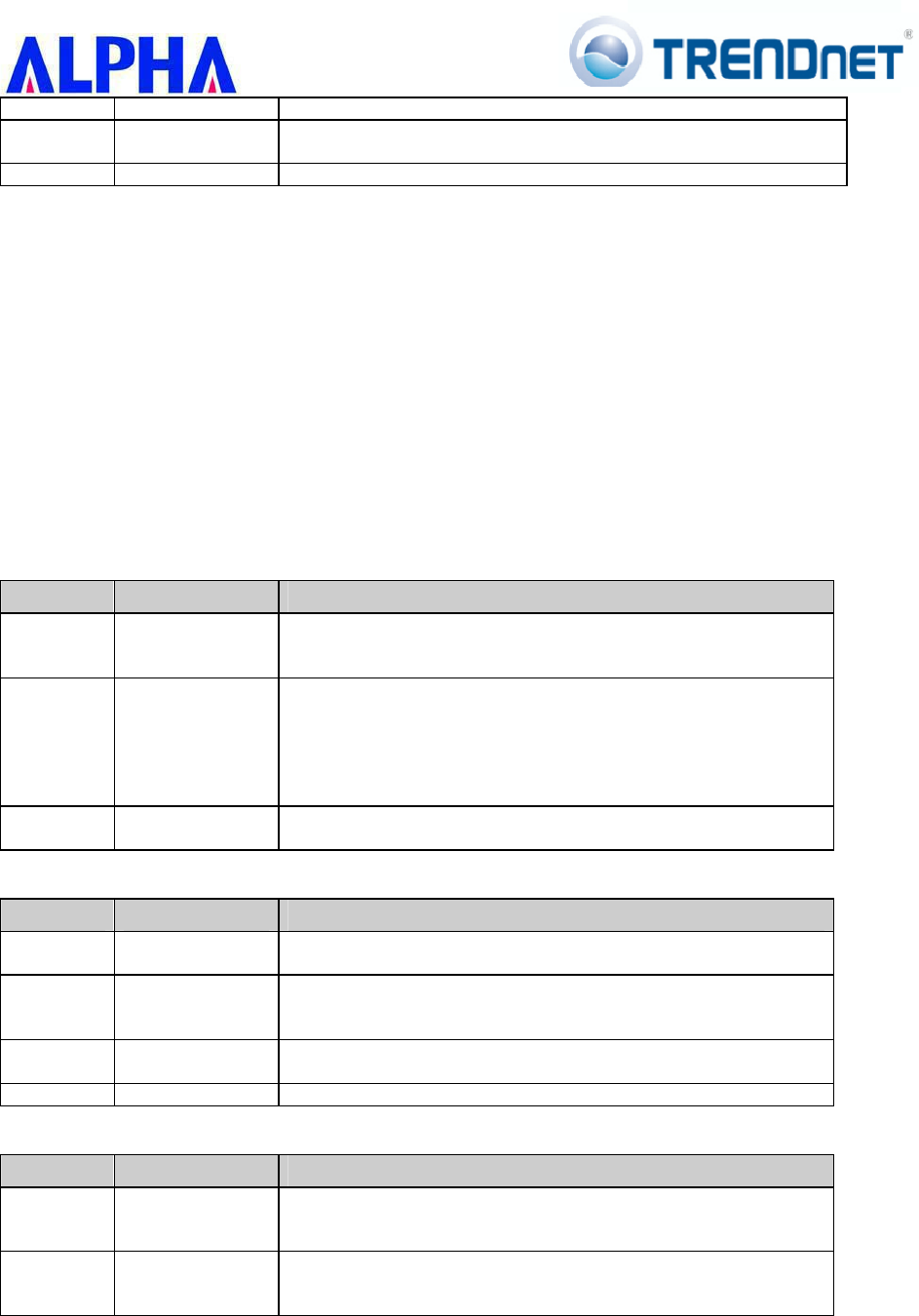
Alpha Networks Proprietary and Confidential Information
2.2.4.2 Operating Voltage
y 5VDC +/- 10%
2.2.4.3 Current
Consumption
y 220mA at continuous transmit mode
y 160mA at receive mode w/o receiving packet
2.2.4.4 USB y High Speed USB2.0 Interface
2.3 Software Requirements
The Configuration Software supports Microsoft Windows 2000, XP 32/64-bit and Vista 32/64-bit. This configuration
software includes the following functions:
y Information
Information allows you to monitor network status.
y Configuration
Configuration allows you to configure parameters for wireless networking.
y Encryption
Encryption provides WEP, WPA, WPA2, and 802.1X security control
y Diagnosis
Diagnosis allows you to display all channel status and search neighboring access points
2.3.1 Information
# Feature Detailed Description
2.3.1.1 General Information
y General Information shows the name of Wireless Adapter, Adapter
MAC Address, Regulatory Domain, Firmware Version, and Utility
Version.
2.3.1.2 Current Link
Information
y Current Link Information shows the Current Setting ESSID, Channel
Number, Associated BSSID, Network Type (infrastructure or Ad-hoc
network), WEP Status (enable or disable), Link Status (Connect or
Dis-connect), 802.11g Transmit Speed (6, 9, 12, 18, 24, 36, 48,
54Mbps), 802.11b Transmit Speed (1, 2, 5.5, 11Mbps), Signal
Strength, and Link Quality.
2.3.1.3 Site survey y To search the neighboring access points and display the information of
all access points.
2.3.2 Configuration
# Feature Detailed Description
2.3.2.1 ESS ID y Input an SSID number if the roaming feature is enabled
y Supports for ASCII printable characters.
2.3.2.2 Network Type y Ad-hoc Mode and 802.11 Ad-hoc Mode for network configurations
that do not have any access points
y Infrastructure Mode for network configurations with access points
2.3.2.3 Transmission Speed
y This indicates the communication rates. Select appropriate
transmission speed to match your wireless LAN settings
2.3.2.4 Roaming y Support Automatic or Manual Rescan to associate with access point.
2.3.3 Encryption
# Feature Detailed Description
2.3.3.1 Encryption y RC4 encryption algorithm
y Support 64/128 bit WEP encryption
y Support open system and shared key authentication
2.3.3.2 WEP Management y Four WEP keys can be selected
y STA with WEP off will never associate any AP with WEP enabled
y WEP Key Format: Option for Hex format